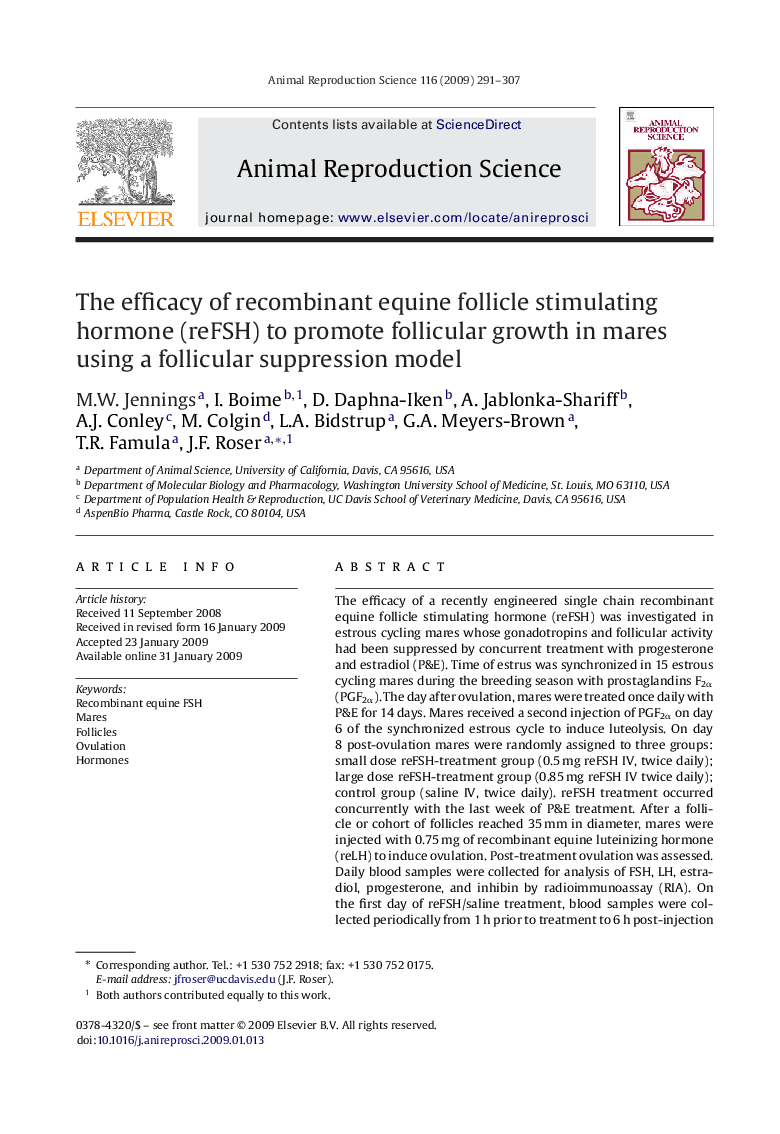| Article ID | Journal | Published Year | Pages | File Type |
|---|---|---|---|---|
| 2073925 | Animal Reproduction Science | 2009 | 17 Pages |
The efficacy of a recently engineered single chain recombinant equine follicle stimulating hormone (reFSH) was investigated in estrous cycling mares whose gonadotropins and follicular activity had been suppressed by concurrent treatment with progesterone and estradiol (P&E). Time of estrus was synchronized in 15 estrous cycling mares during the breeding season with prostaglandins F2α (PGF2α). The day after ovulation, mares were treated once daily with P&E for 14 days. Mares received a second injection of PGF2α on day 6 of the synchronized estrous cycle to induce luteolysis. On day 8 post-ovulation mares were randomly assigned to three groups: small dose reFSH-treatment group (0.5 mg reFSH IV, twice daily); large dose reFSH-treatment group (0.85 mg reFSH IV twice daily); control group (saline IV, twice daily). reFSH treatment occurred concurrently with the last week of P&E treatment. After a follicle or cohort of follicles reached 35 mm in diameter, mares were injected with 0.75 mg of recombinant equine luteinizing hormone (reLH) to induce ovulation. Post-treatment ovulation was assessed. Daily blood samples were collected for analysis of FSH, LH, estradiol, progesterone, and inhibin by radioimmunoassay (RIA). On the first day of reFSH/saline treatment, blood samples were collected periodically from 1 h prior to treatment to 6 h post-injection via an indwelling jugular catheter to determine acute changes in FSH concentrations. Monitoring of follicular activity, estrus, and ovulation was performed daily by utilizing a stallion and transrectal ultrasonography.A difference (p ≤ 0.05) between the largest diameter follicle in the reFSH-treatment groups compared to controls occurred on day 14 post-ovulation, the day treatments ended, and the difference continued until day 21 post-ovulation. reFSH-treatment groups had larger (p ≤ 0.05) numbers of 20–29 mm follicles (days 13–18), 30–34 mm follicles (days 15–20) and ≥35 mm follicles (days 16–21) than controls. Mares treated with reFSH, at either dose, took less time (average: 2.95 ± 0.42 days) to develop 2–3 times more pre-ovulatory follicles than control mares (7.8 ± 0.51 days) (p ≤ 0.05). The number of ovulations between treated mares and controls were similar due to a greater incidence of ovulation failure in reFSH-treated mares. During reFSH treatment, concentrations of plasma FSH, inhibin and estradiol were greater (p ≤ 0.05) compared to control concentrations. Plasma LH concentrations in reFSH-treated mares were suppressed and did not exhibit the ovulatory surge of controls (p ≤ 0.05). Plasma progesterone concentrations were not different across groups.These findings demonstrate the specific effects of reFSH to increase number of total follicles including pre-ovulatory follicles in mares with endogenous pituitary gonadotropins and follicular growth suppressed by a regimen of P&E.
